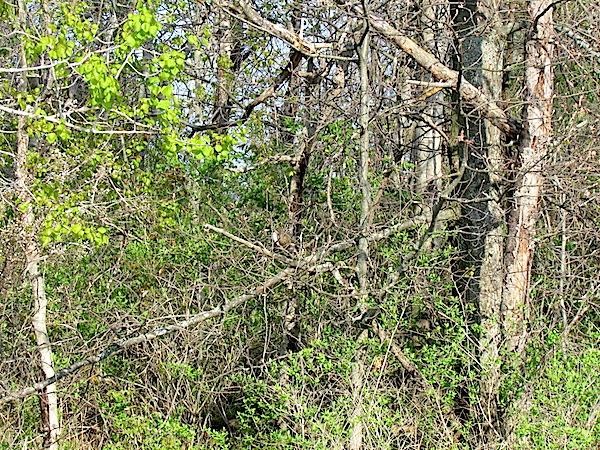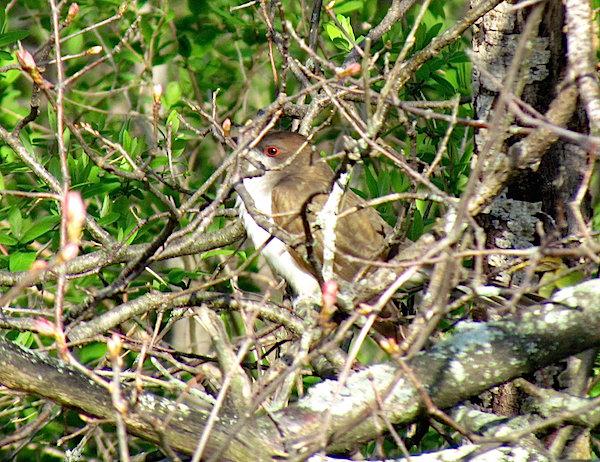
From a distance, trying to point out a bird to a companion can be difficult if you don't use concise directions. Do you see the bird? It's right in the middle of the photo/Kirby Adams.
"It's right in that tree,' he said, pointing at a grove of approximately 50 small trees. 'It's on a horizontal branch. Right there in the tree with the green leaves. Can't you see it?'
That's one side of a conversation I heard this weekend, one of hundreds like it. I've spent the last couple of weeks around lots of birders, many of them relatively new to the hobby. Hearing birders giving directions to other birders about a bird can be painful. It's equally frustrating to both the person who sees the bird and the one who doesn't when the directions just aren't clicking. Since one of the joys of birding with friends - and even strangers - is sharing the birds you spot first, it's important to be able to give good directions.
One of the least helpful things you can do is point and say, 'It's right there.' Even if your birding companion is standing literally shoulder-to-shoulder with you, her angle of view toward your extended finger will give her an arc of about 45 degrees in which you might be pointing. Pointing does little more than to narrow it down to the cardinal directions from your position. In the worst case, having a person stand directly behind you while you point can help, but it's easier to try the following tips first.
Use Landmarks
'See the red barn? Along the hill behind and to the right of it is a big white building. In front of that building, but down in this field are two tall trees. The bird is in the tuft of weeds just in front of the right of those two trees.' Those are excellent directions. Pick an obvious landmark to start. No one can miss a big red barn. Then move from that starting mark to adjacent marks until you get to the bird.
Sometimes the landmarks are close at hand. 'See the tree with the sun shining on the trunk? Follow that up to the first branch that goes off to the left. Follow that branch out until you see a vine dangling from it. Got that spot? Now look about four feet directly above there. It's in that leafy area.'
You're essentially holding the persons hand and dragging them to the bird. Have them confirm along the way that they're seeing each landmark so you don't lose them and have to retrace steps. You want to do this quickly before the bird leaves, but also effectively.
Clouds can come into play with flying birds. 'See the leftmost windmill on that ridge? Go above it and pick up that jet contrail. Follow it to the right until it hits a big oval cloud. The hawks are circling to the right of that cloud.'
Provide Commentary on Flying Birds
'Bird is flying left. Above the treeline. Passing over some tall pines. Continuing left. Dipped below treeline. Still visible. Passing over the pond. Above treeline again'¦'
When a bird is in flight, speed is essential. There's no time to pick out a barn and methodically guide people to the bird. A moving target requires dynamic directions. The most important first piece of information is which direction the bird is flying. That always comes first so that observers can start ahead of the bird and backtrack toward it with their binoculars. Otherwise they might scan around behind the bird and never have it intersect their field of view.
Once direction of flight is established, just stay with the bird and describe what you're seeing. Whether it's above or below the horizon or distant treelines is critical. After that, describe landmarks it's passing over.

Clear directions can quickly help someone find a bird you see, like this Black-billed Cuckoo in a thicket of branches/Kirby Adams
Know Your Audience
I bird with some people for whom 'It's above the third spruce,' would be quite helpful, and others for whom that direction would be useless because they don't know one conifer from another. With strangers it's safer to assume they don't know trees. Describe trees as 'tall,' 'leafless,' 'darker green than the rest,' or something like that. Same goes for birds, cars, or anything else as landmarks. The birders with you may not be able to quickly pick out the American Wigeon or the '89 Impala as landmarks.
Take a Picture
This is a purely 21st century trick, although I suppose it could have worked with Polaroids.
Last Saturday I stumbled into a group of birders, mostly strangers to each other, who were looking at a partially obscured Black-billed Cuckoo. One woman in the group simply couldn't find the bird. I listened to the directions being given and they were pretty good, but this poor birder was getting frustrated and just not picking up on the landmarks. I stood behind her and saw that she was well off of where the bird was, so instead of frustrating her further, I took a photo of the wall of forest in front of us and walked over to her with the photo on the viewscreen of my camera.
'This is the view in front of you, right? See these two branches that cross,' I said, drawing my finger along them on the photo. She said yes, so I continued by pointing to a tiny white spot on the photo. 'That's the bird,' I said.
She put her binoculars back up and had the bird in five seconds. Frustration turned to glee and we all enjoyed the bird.
These techniques work with anything: an elk on a hillside in Yellowstone National Park, an orchid across a bog in Glacier National Park, or a coiled copperhead near Mammoth Cave National Park. Keep calm, give clear directions, and don't be the person who just keeps yelling, 'It's right there!' while pointing emphatically.



Comments
Kirby - been there and done that, on both sides of the conversation :-)
Thanks for some practical tips!
My aging eyes have floaters, which can make it difficult to pick out the real bird against a blank sky!
Thanks Kirby! I, and my wife, live this story on every birding trip. Your advice will make for more productive, and less stressful, birding. The only thing left is to get our eyes at the same level. Maybe I can find some lifts for her shoes!
Mike